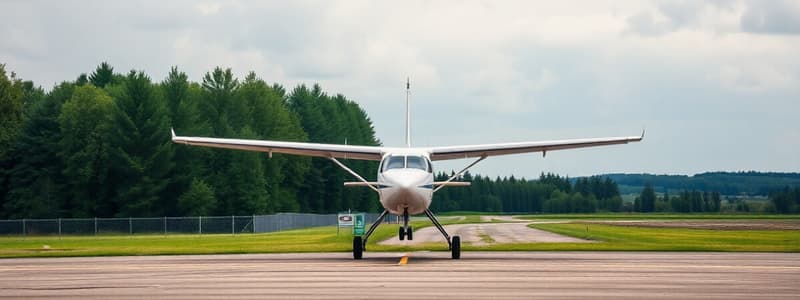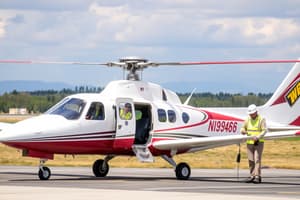Podcast
Questions and Answers
What must be added to the actual landing distance when determining the required landing distance in the event of system failure?
What must be added to the actual landing distance when determining the required landing distance in the event of system failure?
- Operational factors
- Air traffic control recommendations
- RWYCC adjustments
- Increments for the malfunction (correct)
Which of the following statements about aerodrome operating minima is TRUE?
Which of the following statements about aerodrome operating minima is TRUE?
- Operating minima can be calculated for non-planned alternate aerodromes. (correct)
- Aerodrome minima can be lower than those established by the State.
- Minimums must be universally applicable to all aerodromes.
- Every aerodrome must have the same operating minima.
What is the relationship between aircraft performance information and RWYCC as discussed in the assessment of the LDTA?
What is the relationship between aircraft performance information and RWYCC as discussed in the assessment of the LDTA?
- Aircraft performance information correlates with RWYCC for the intended runway. (correct)
- Aircraft performance is evaluated only on smooth runways.
- Aircraft performance is independent of RWYCC.
- RWYCC is irrelevant to landing performance calculations.
What is the minimum requirement for the aerodrome operating minima when performing calculations?
What is the minimum requirement for the aerodrome operating minima when performing calculations?
Which of the following is NOT a requirement when calculating landing distances under abnormal operation conditions?
Which of the following is NOT a requirement when calculating landing distances under abnormal operation conditions?
What is the maximum correction to the minimum obstacle clearance altitude for wind speed adjustments?
What is the maximum correction to the minimum obstacle clearance altitude for wind speed adjustments?
How much should the minimum obstacle clearance altitude be increased if the ambient temperature is ISA -20°C?
How much should the minimum obstacle clearance altitude be increased if the ambient temperature is ISA -20°C?
What is the allowable temperature deviation that results in an altimeter reading off by approximately 20%?
What is the allowable temperature deviation that results in an altimeter reading off by approximately 20%?
What adjustment must be made to the MOCA when flying within 20 NM of terrain exceeding 2000 ft?
What adjustment must be made to the MOCA when flying within 20 NM of terrain exceeding 2000 ft?
If a pilot is assigned to maintain an altitude of 8,000 ft, what must they not do regarding temperature corrections?
If a pilot is assigned to maintain an altitude of 8,000 ft, what must they not do regarding temperature corrections?
What is implied by the term 'adequate' concerning aerodromes for aircraft operations?
What is implied by the term 'adequate' concerning aerodromes for aircraft operations?
Which category of aircraft requires an aerodrome ARFF code of 8?
Which category of aircraft requires an aerodrome ARFF code of 8?
Which of the following situations requires further incrementing the minimum obstacle clearance altitude?
Which of the following situations requires further incrementing the minimum obstacle clearance altitude?
What is the consequence of the ambient temperature being much colder than predicted in relation to minimum flight altitude?
What is the consequence of the ambient temperature being much colder than predicted in relation to minimum flight altitude?
Who is responsible for ensuring the usability of aerodromes selected as AEROTRANSCARGO destinations?
Who is responsible for ensuring the usability of aerodromes selected as AEROTRANSCARGO destinations?
What is the first step if the surface temperature is ISA -32°C?
What is the first step if the surface temperature is ISA -32°C?
What is required for airports with ARFF categories 5 or 6 to be used?
What is required for airports with ARFF categories 5 or 6 to be used?
What should pilots do if their assigned altitude does not meet adjusted MOCA criteria?
What should pilots do if their assigned altitude does not meet adjusted MOCA criteria?
What type of services must be available at an aerodrome for aircraft performance calculations?
What type of services must be available at an aerodrome for aircraft performance calculations?
In what context should contaminated runways be considered?
In what context should contaminated runways be considered?
What is necessary for aerodromes planned as destinations or alternates?
What is necessary for aerodromes planned as destinations or alternates?
What is the primary responsibility of the Commander regarding aircraft operation?
What is the primary responsibility of the Commander regarding aircraft operation?
What takes precedence if AEROTRANSCARGO’s operating policies are more restrictive than legal requirements?
What takes precedence if AEROTRANSCARGO’s operating policies are more restrictive than legal requirements?
For what scenarios is an Operational Flight Plan (OFP) not required?
For what scenarios is an Operational Flight Plan (OFP) not required?
What does Chapter 8 emphasize regarding operating procedures?
What does Chapter 8 emphasize regarding operating procedures?
If a fleet cannot comply with a specific policy, what should apply?
If a fleet cannot comply with a specific policy, what should apply?
What is stated about the compliance of AEROTRANSCARGO aircraft operations?
What is stated about the compliance of AEROTRANSCARGO aircraft operations?
In what context must AEROTRANSCARGO aircraft operate when providing commercial air transportation?
In what context must AEROTRANSCARGO aircraft operate when providing commercial air transportation?
What must the Commander verify before commencing an approach to land at a destination aerodrome with a single runway?
What must the Commander verify before commencing an approach to land at a destination aerodrome with a single runway?
Under which condition is it not mandatory to calculate landing performance for an aeroplane?
Under which condition is it not mandatory to calculate landing performance for an aeroplane?
What tool does AEROTRANSCARGO use for the calculation of aircraft landing performances?
What tool does AEROTRANSCARGO use for the calculation of aircraft landing performances?
What is a prerequisite for dispatching an aeroplane if sub-paragraph c) ii) is not complied with?
What is a prerequisite for dispatching an aeroplane if sub-paragraph c) ii) is not complied with?
What does the OPT Landing Module provide for landing calculations?
What does the OPT Landing Module provide for landing calculations?
Which of the following statements is correct regarding tailwind and LDA conditions?
Which of the following statements is correct regarding tailwind and LDA conditions?
What is the function of EFRAS software within AEROTRANSCARGO?
What is the function of EFRAS software within AEROTRANSCARGO?
What requirement exists for an aeroplane dispatched towards a destination aerodrome with a single runway?
What requirement exists for an aeroplane dispatched towards a destination aerodrome with a single runway?
What is the maximum RWYCC that a RWYCC 1 or 0 can be upgraded to by the aerodrome operator?
What is the maximum RWYCC that a RWYCC 1 or 0 can be upgraded to by the aerodrome operator?
When reporting a RWYCC for a runway contaminated with compacted snow, what designation is used when specifically treated?
When reporting a RWYCC for a runway contaminated with compacted snow, what designation is used when specifically treated?
What information is specified in the 'situational awareness' section of the RCR when an upgrade happens?
What information is specified in the 'situational awareness' section of the RCR when an upgrade happens?
What term is used in the RCR to indicate that a reported RWYCC is lower than actual due to quality doubts?
What term is used in the RCR to indicate that a reported RWYCC is lower than actual due to quality doubts?
What is prohibited in operations when less-than-poor braking action is present?
What is prohibited in operations when less-than-poor braking action is present?
What can the aerodrome operator NOT do regarding the RWYCC based on contaminant type as observed?
What can the aerodrome operator NOT do regarding the RWYCC based on contaminant type as observed?
What minimum condition must a specially prepared winter runway meet regarding contaminants?
What minimum condition must a specially prepared winter runway meet regarding contaminants?
What happens to the reported RWYCC if the aerodrome operator is in doubt about the surface quality?
What happens to the reported RWYCC if the aerodrome operator is in doubt about the surface quality?
Flashcards
Operational Flight Plan (OFP)
Operational Flight Plan (OFP)
A document that outlines the flight plan, including details like route, fuel requirements, and other relevant information.
Aircraft Flight Manual
Aircraft Flight Manual
A comprehensive document that contains operational limitations and procedures specific to an aircraft type.
Certificate of Airworthiness
Certificate of Airworthiness
A document issued by a regulatory authority, authorizing an aircraft to operate safely.
Air Operator Certificate
Air Operator Certificate
Signup and view all the flashcards
Commander
Commander
Signup and view all the flashcards
Operating Policies
Operating Policies
Signup and view all the flashcards
Operations Manual Part B
Operations Manual Part B
Signup and view all the flashcards
Operations Manual Part A
Operations Manual Part A
Signup and view all the flashcards
What is MOCA?
What is MOCA?
Signup and view all the flashcards
How does wind affect MOCA?
How does wind affect MOCA?
Signup and view all the flashcards
What's the adjustment for wind speed when near MOCA?
What's the adjustment for wind speed when near MOCA?
Signup and view all the flashcards
How do mountain waves impact MOCA?
How do mountain waves impact MOCA?
Signup and view all the flashcards
When do you need to consider adjustments for wind?
When do you need to consider adjustments for wind?
Signup and view all the flashcards
How does temperature affect MOCA?
How does temperature affect MOCA?
Signup and view all the flashcards
How do you adjust the MOCA for temperature?
How do you adjust the MOCA for temperature?
Signup and view all the flashcards
Can pilots adjust altitudes for cold temperatures?
Can pilots adjust altitudes for cold temperatures?
Signup and view all the flashcards
Warm temperatures and their effect on aircraft performance
Warm temperatures and their effect on aircraft performance
Signup and view all the flashcards
Who is responsible for ensuring aerodrome suitability?
Who is responsible for ensuring aerodrome suitability?
Signup and view all the flashcards
What does 'adequate' mean in the context of airport suitability?
What does 'adequate' mean in the context of airport suitability?
Signup and view all the flashcards
What are the minimum fire fighting requirements for an airport?
What are the minimum fire fighting requirements for an airport?
Signup and view all the flashcards
What are the fire fighting levels Aerotranscargo typically uses?
What are the fire fighting levels Aerotranscargo typically uses?
Signup and view all the flashcards
Where can you find more information about RFF requirements?
Where can you find more information about RFF requirements?
Signup and view all the flashcards
What are the criteria for selecting airports as alternates?
What are the criteria for selecting airports as alternates?
Signup and view all the flashcards
How do warm temperatures impact altimeter readings?
How do warm temperatures impact altimeter readings?
Signup and view all the flashcards
What is a SPECIALLY PREPARED WINTER RUNWAY?
What is a SPECIALLY PREPARED WINTER RUNWAY?
Signup and view all the flashcards
RWYCC 4 SPECIALLY PREPARED WINTER RUNWAY
RWYCC 4 SPECIALLY PREPARED WINTER RUNWAY
Signup and view all the flashcards
DOWNGRADED RWYCC on a winter runway
DOWNGRADED RWYCC on a winter runway
Signup and view all the flashcards
Can a RWYCC be upgraded?
Can a RWYCC be upgraded?
Signup and view all the flashcards
Can a RWYCC be upgraded based only on observations?
Can a RWYCC be upgraded based only on observations?
Signup and view all the flashcards
Can a RWYCC be downgraded based on AIREPs?
Can a RWYCC be downgraded based on AIREPs?
Signup and view all the flashcards
What should be considered when determining the RWYCC?
What should be considered when determining the RWYCC?
Signup and view all the flashcards
What happens when runway braking action is less than 'poor'?
What happens when runway braking action is less than 'poor'?
Signup and view all the flashcards
Required Landing Distance
Required Landing Distance
Signup and view all the flashcards
Aerodrome Operating Minima (AOM)
Aerodrome Operating Minima (AOM)
Signup and view all the flashcards
Minimum Operating Minima
Minimum Operating Minima
Signup and view all the flashcards
Landing Distance in Abnormal Operations
Landing Distance in Abnormal Operations
Signup and view all the flashcards
Alternate Aerodrome
Alternate Aerodrome
Signup and view all the flashcards
Landing Distance Available (LDA)
Landing Distance Available (LDA)
Signup and view all the flashcards
Wind Component
Wind Component
Signup and view all the flashcards
Landing Performance Requirements
Landing Performance Requirements
Signup and view all the flashcards
OPT (Boeing Onboard Performance Tool)
OPT (Boeing Onboard Performance Tool)
Signup and view all the flashcards
Landing Distance Required (LDR)
Landing Distance Required (LDR)
Signup and view all the flashcards
EFRAS Software
EFRAS Software
Signup and view all the flashcards
Non-Compliance with Landing Requirements
Non-Compliance with Landing Requirements
Signup and view all the flashcards
Study Notes
Introduction
- All AEROTRANSCARGO aircraft operations must comply with their respective Certificates of Airworthiness, approved limitations in Aircraft Flight Manuals, and commercial air transportation regulations/air operator certificates.
- Commanders are responsible for ensuring operations comply with Moldovan law and legal requirements of other states. AEROTRANSCARGO's operating policies supersede any less restrictive regulations.
Flight Preparation Instructions
- An Operational Flight Plan (OFP) is required for all flights, except those specified.
- The Commander must ensure the aircraft is airworthy, configured correctly, that essential instruments and equipment are available and operable (except under MEL), and that relevant Operations Manual parts are on board.
- Maps, charts, documents, and any potential diversions must be available.
- Ground facilities and services, fuel, oil, oxygen, altitude requirements, aerodrome minima, and alternate aerodromes (if required) must be available and adequate.
- Aircraft load must be properly distributed and secured.
Minimum Flight Altitudes
- All AEROTRANSCARGO flights must adhere to Instrument Flight Rules (IFR) and maintain a safe margin above terrain/obstacles, as defined by national regulations.
- Minimum Obstacle Clearance Altitude (MOCA) is calculated by adding a safe margin to the elevation of the highest relevant terrain/obstacle.
- For elevations up to 6,000ft, a 1,000ft margin applies.
- For elevations exceeding 6,000ft, a 2,000ft margin applies, rounded up to the nearest 100ft.
- The minimum MOCA is 2,000ft.
Minimum Off-Route Altitude
- When not following a pre-determined route (navigational fixes), the lowest published altitude within the operating area must be observed.
- Navigation charts provide minimum altitudes for a grid formed by latitude and longitude lines.
Minimum Altitude in Terminal Areas
- Minimum altitudes in terminal areas, displayed on terminal charts, provide clearance over obstacles within a 25-nautical mile radius of the aerodrome or navigation facility.
Minimum Radar Vectoring Altitude (MRVA)
- MRVA is 1,000 ft within a minimum band width of ± 5 nm (radar unit control).
- Operations at MRVA are only permitted when the aircraft is advised as being "under radar control".
Operational Flight Plan (OFP) Minimum Altitude
- Minimum altitudes on the OFP may differ from navigational chart altitudes, especially within 20nm of the route centerline.
Obstacle Clearance Performance Requirements
- Multi-engine aircraft are classified into performance classes (A, B, C) according to seating configuration and maximum takeoff mass.
- AEROTRANSCARGO aircraft are all classified as Class A.
- Specific performance standards (e.g. one-engine inoperative en-route net flight path requirements with fuel considerations) apply to Class A aircraft.
Minimum Altitude/Flight Level to be Flown
- During normal operations, the minimum altitude/flight level is identified on the relevant terminal chart per leg of the flight/operation.
- Under radar control, the minimum altitude/flight level is established by the radar controller.
Studying That Suits You
Use AI to generate personalized quizzes and flashcards to suit your learning preferences.
Related Documents
Description
Test your knowledge on aviation safety protocols, specifically focusing on landing distances and aerodrome operating minima. This quiz covers critical calculations and adjustments necessary for safe operations in various conditions and emergencies. Prepare to engage with topics pertaining to aircraft performance and obstacle clearance requirements.




